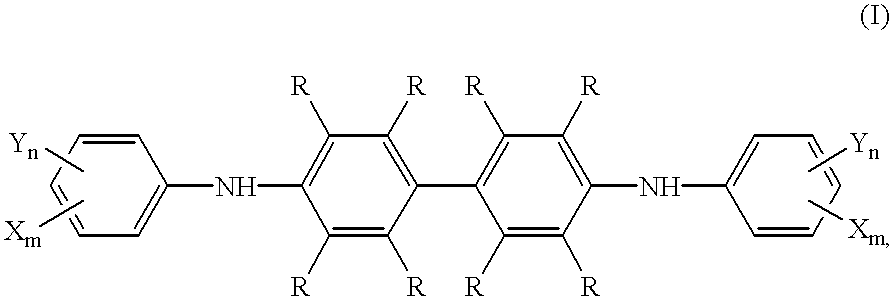Testing element for the colorimetric determination of oxidizable components in gas mixtures
a colorimetric and oxidizable technology, applied in the field of testing elements, can solve the problems of color change, low intrinsic color intensity in many reagent systems, etc., and achieve the effect of intense color chang
- Summary
- Abstract
- Description
- Claims
- Application Information
AI Technical Summary
Benefits of technology
Problems solved by technology
Method used
Image
Examples
example 1
Synthesis of N,N'-Bis[2,3,5,6-tetrafluoro-4-(trifluoromethyl)-phenyl]-benzidine
A mixture of benzidine (10 mmoles, 1.84 g), octafluorotoluene (20 mmoles, 4.60 g), pyridine (20 mmoles, 1.58 g), and 40 mL of DMSO were stirred for 4 hours at 100.degree. C. The solution was then cooled to room temperature, charged into 0.5% aqueous hydrochloric acid (100 mL), extracted with methylene chloride (4.times.50 mL), and dried over Na.sub.2 SO.sub.4. The solvent was drawn off via a silica gel column and the rest was recrystallized from toluene / heptane (1:1, v / v). Yield: 1.1 (18%), melting point 179-180.5.degree. C.
example 2
Reduction of the Chromate Concentration in Detector Tubes
The Alco-Check.TM. detector tube currently being used is yellow due to the coating with chromate(VI). The color changes to green in the presence of ethanol. If the chromate is reduced to one twentieth of the original quantity, the yellow color is no longer perceptible to the naked eye. If the redox indicator from Example 1 was added, the color of the detector tube changed to deep pink. The addition of small amounts of ethanol then led to colorization.
The preparation thus prepared was about 10 times more sensitive than the detector tubes currently known.
As an alternative, the preparation is colored reddish brown by Nile blue (5 mg); the chromate reagent turns yellow on contact with ethanol or methanol.
As an alternative, thionine acetate (5 mg) is used as the indicator, the preparation turns green; the chromate reagent turns blue on contact with alcohol.
As an alternative, using sodium salt of 2,6-dichlorophenol indophenol (5 mg)...
example 3
Detector Tubes with Silica Gel as the Carrier Material
Twenty g of wide-pored silica gel of a particle size of 0.3-0.4 mm is mixed with 100 mg of potassium dichromate and 2.5 mL of concentrated sulfuric acid. The color of the preparation is a very faint yellow. The color of the reagent changes to deep pink by the addition of 10 mg of N,N'-bis[2,3,5,6-tetrafluoro-4-(trifluoromethyl)-phenyl]-benzidine. The preparation thus prepared becomes decolorized upon the addition of ethanol vapor.
PUM
 Login to View More
Login to View More Abstract
Description
Claims
Application Information
 Login to View More
Login to View More - R&D
- Intellectual Property
- Life Sciences
- Materials
- Tech Scout
- Unparalleled Data Quality
- Higher Quality Content
- 60% Fewer Hallucinations
Browse by: Latest US Patents, China's latest patents, Technical Efficacy Thesaurus, Application Domain, Technology Topic, Popular Technical Reports.
© 2025 PatSnap. All rights reserved.Legal|Privacy policy|Modern Slavery Act Transparency Statement|Sitemap|About US| Contact US: help@patsnap.com



